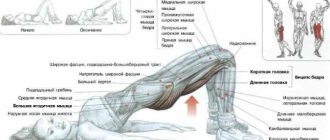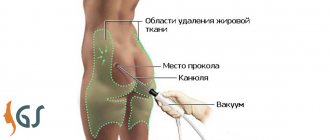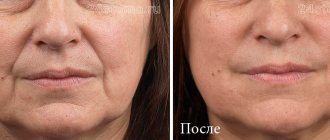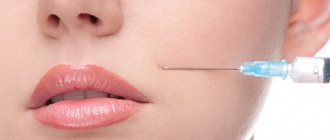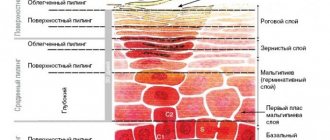Degrees of buttock drooping
The process of prolapse of the soft tissues of the buttocks is conventionally divided into:
- preptosis: when a fold of skin begins to form at the border of the buttock and thigh;
- ptosis itself: a fold is formed and the tissue of the buttocks begins to hang over the skin fold.
If we talk about filament lifting, it is effective only in the case of preptosis. In this case, the threads allow you to slightly lift the skin and subcutaneous fatty tissue, create volume in the upper part of the buttocks, and prevent further tissue sagging.
In the case of ptosis, they can only provide a temporary effect. The risk of filament lifting complications increases, such as thread cutting and the formation of continuous skin retractions in the places where it passes.
Contraindications
You shouldn’t rely too much on the magic phrase in thread lift advertising that the method has virtually no contraindications. They exist, just not as strict as in the case of surgery.
These include:
- pregnancy;
- formation of keloid or hypertrophic skin scars in response to damage;
- autoimmune diseases;
- colds, infectious diseases;
- diseases of the skin and subcutaneous tissue of any location;
- allergy;
- blood diseases, disorders of blood clotting processes;
- oncological diseases;
- diabetes.
Causes of asymmetry of folds on the legs
Wrinkles on babies' legs, back and arms are natural in the nature of newborns. Their number can be completely different, since the weight of babies varies. As a rule, as the baby grows, the folds disappear, the body stretches, the child grows, and by the age of one year there are usually no irregularities on the body.
Asymmetry of the limbs is detected already in the maternity hospital, since this is not the norm and indicates the presence of a disease. If the baby's hip joints are not sufficiently developed, then when straightening, the infant's legs will not align. Often, if the length of the limbs is not the same, then asymmetric folds on the newborn’s body are clearly visible. The cause of this pathology is a violation of the development of the child in the womb.
Important! The clinical picture is considered aggravated when, when trying to separate the baby’s legs, tension is felt and a characteristic click is heard.
An orthopedic problem can be solved quite quickly, but only with timely contact with a specialist. The later the visit, the more difficult the treatment will be. In some cases, you cannot help the child - lameness will develop, which will accompany him throughout his life.
Muscle hypertonicity
This means that the muscles on one side of the body are more tense than the other, resulting in asymmetry. However, it can occur not only in folds. Muscle tone is studied by a pediatrician and a neurologist during examination, and subsequently an assessment of the condition is made.
Hypertonicity can be of three types:
- Spastic hypertension. It is assessed after flexion and extension of the legs and arms, does not change after manipulation, remaining the same high.
Hypertonicity of muscles and tilting of the head
- Plastic hypertension or rigidity. The resistance is more uniform, jerky. The legs can be additionally reinforced.
- Physiological hypertonicity. Characteristic for babies in the first weeks of life. This is the so-called “fetal position”, which the baby constantly strives to occupy. There is no need to treat this type; the child himself will adapt to the new world after some time.
Why do newborns have increased muscle tone?
- The pregnancy was complicated by endocrinological and cardiovascular diseases;
- Chromosomal abnormality and congenital diseases that caused an increase in tone;
- Birth injuries of the baby;
- Intrauterine hypoxia;
- Defects and anomalies in the development of the brain and spinal cord;
- Rh conflict with the mother, which results in hemolytic disease.
Note! This disease can be prevented. It is important to have your pregnancy managed by competent obstetricians and gynecologists.
- Intrauterine infection;
- Neuropsychic stress throughout pregnancy;
- Meningitis, encephalitis and other injuries that the child suffered after birth.
Improper swaddling
Evgeny Komarovsky, a children's pediatrician, recommends loose swaddling of children. If you pull your legs closer to each other every day and then fix them, this can lead to the development of dysplasia. The joints will function better if you refuse this procedure or choose another option - wide swaddling[1].
Tight swaddling
Hip dysplasia is characterized by the presence of a large number of folds on the body.
Congenital feature
The folds on a child’s legs may be asymmetrical due to individual characteristics. Even an adult has such irregularities on the body: asymmetry in the arms, legs, face, and fat deposits. It is easy to identify a congenital feature - just go for an examination to an orthopedist or take an x-ray.
Large baby weight
If the baby was born more than 4 kg, then it is natural that the baby will have asymmetry of folds on the legs and arms. This happens due to the large amount of fat deposits that are unevenly distributed throughout the body.
Large children have many folds on their body
Hip dysplasia
This is a disease characterized by abnormal development of joints. A surgeon and orthopedist examine the child in the maternity hospital; at a routine examination at 1 month, an ultrasound is prescribed, if necessary.
At an early age, the disease can be effectively treated. If you strictly and regularly follow all the doctor’s instructions, then it will be cured in one year. If dysplasia is allowed to start, it can lead to unpleasant consequences:
- Scoliosis and osteochondrosis;
- Deformation of healthy joints;
- Lameness for life;
- Displacement of internal organs and heavy load on them;
- The occurrence of inflammatory processes and pain that will require surgical intervention.
What are the dangers of dysplasia?
Why does dysplasia occur?
- inherited from parents;
- the birth occurred in a breech position;
- the fetus was born large;
- deformation of the feet occurred during childbirth or in the womb;
- if the baby was swaddled tightly and the legs were straightened.
What types of threads can be used
Polypropylene threads
Aptos threads are most often used. They have microscopic notches that allow you to securely fix the tissue in a certain position. Polypropylene threads do not cause allergies or rejection reactions. They do not dissolve.
Absorbable polylactic acid sutures
Polylactic acid gradually breaks down in tissues to form lactic acid. And lactic acid, in turn, has a stimulating effect on metabolism and the synthesis of collagen and elastin. After the thread is completely absorbed, a framework of collagen and elastin remains in its place, which prevents the development of tissue prolapse.
In addition to revitalizing, polylactic acid threads also have a mechanical effect. They have notches for fixing tissues in a taut position.
If we consider that polylactic acid threads dissolve within 8-9 months, then we can confidently say that they have a prolonged lifting effect.
Video: Aptos Threads
Mesothreads
If the first two types of threads are suitable for correcting drooping buttocks, then lifting with mesothreads is used only for the prevention of ptosis. They do not have notches, therefore they cannot provide a significant degree of tension and lifting of tissues. Mesothreads consist of polydioxanone and are coated on top with polyglycolic acid.
When absorbed, mesothreads stimulate the production of collagen and elastin in the skin and the creation of a frame that will support the skin in a certain position.
Mesothreads are good for those who are satisfied with their own appearance and want to maintain their shape for a long time.
For photos before and after hand plastic surgery, see the article - brachioplasty.
Learn all about the reasons why your butt may be less than ideal and watch the video: Brazilian butts here.
Endoprosthetics or gluteoplasty
But how can you remove ptosis of the buttocks and increase volume if you don’t have enough of your own tissue? In this case, endoprosthetics (or gluteoplasty) is used. Buttock prostheses are similar to breast implants.
They have a durable silicone shell and a special gel inside. They can be round or pear-shaped. Prostheses are selected individually for each person so that they add the required volume and do not harm the sciatic nerve.
Implants can be installed under the muscle or under the skin. The first option is used more often. This is due to the fact that the muscles securely hold the prosthesis; it is not visible in any position of the body. Also, the implant does not move.
After this method, a person feels discomfort for about a year. During this time, the body will get used to the foreign body. Also, the prosthesis can be felt during sports when muscles contract.
Over time, muscle atrophy occurs due to the pressure of the implant, which may not be corrected when playing sports.
How the procedure is performed
Local anesthesia is used for the procedure. It takes from 30 to 60 minutes. The place where the threads are inserted is treated with antiseptics. Threads are inserted through punctures or small incisions in the skin using needles or cannulas.
After all the threads have been inserted, they are tensioned and their ends are trimmed. Since anesthesia is not used during the procedure, the patient can observe the process of tightening the threads and determine the degree of their tension and the appearance of the buttocks, which is obtained.
After removing the cannulas and cutting the ends of the threads, the puncture sites are treated with an antiseptic and sealed with adhesive tape. It is imperative that cold is applied to the site where the threads are inserted for about an hour to reduce tissue swelling and to prevent bruising.
Carrying out the operation
The process of installing the selected type of threads, although it is the least traumatic and safe for health, however, requires the surgeon performing it to have sufficient theoretical and practical experience. The entire period of the operation is divided into the preparatory stage, the operation itself to install the threads, as well as the subsequent rehabilitation period, the duration of which depends on the accuracy of following the doctor’s recommendations.
Buttock lift with threads and volume increase using lipofilling
Preparation
The preparatory process consists of an external examination of the buttock area to determine the degree of sagging skin, the appearance of cellite, and determine the best type of threads for the operation. The following tests are also taken to obtain the most complete picture of the patient’s health:
- general blood analysis;
- coagulogram;
- general urine analysis;
- blood chemistry.
The listed tests give an idea of the presence or absence of inflammatory and acute infectious diseases in the body, and the general state of the immune system. Often an ECG is also added here.
Progress of the operation
Before the operation begins, the area of the buttocks and back of the thighs is completely cleaned and disinfected, anesthesia is administered (mostly general intravenous), and then the threads are installed. To do this, minimally sized incisions or punctures are made on the surface of the skin of the buttocks, through which the selected type of thread is installed.
After the insertion of the threads, the surface of the skin of the buttocks is disinfected to prevent the risk of infection entering the body. This is followed by a rehabilitation period, which may vary in duration depending on the quality of the skin, its ability to self-heal, and the presence of side effects after the installation of the selected type of threads.
Recovery period
During the rehabilitation period after the procedure, a number of restrictions must be observed in order to:
- avoid cutting threads and redistributing tissues with the formation of longitudinal tubercles and depressions;
- prevent infection of skin puncture sites;
- reduce swelling of the skin and prevent swelling from increasing.
Typically, restrictions must be observed for at least 20 days, since this is how long it takes for a connective tissue capsule to form around the threads. The entire recovery period can take up to one and a half months.
What to do:
- reduce physical activity, avoid significant range of motion in the hip joints, sudden movements with significant muscle effort (sharp lifting of something heavy, for example);
- do not massage the area of the procedure, do not sit on anything hard;
- treat puncture sites with antiseptics;
- in the first days, cold can be applied to the buttocks;
- Any thermal procedures are not recommended, not only visiting the sauna and solarium, but also taking a hot bath.
If pain bothers you, you can take painkillers as needed.
Reviews
The majority of patients who have undergone filament lifting of the buttocks speak exceptionally well of its effectiveness and the minimal number of possible side effects after implementation. The most frequently noted features of this type of buttock line correction are the elimination of even the advanced stage of cellulite, an increase in the degree of skin elasticity, and an increase in the degree of its smoothness and elasticity.
Many people note a rapid manifestation of a positive result, maintaining it for 1.5-2 years. However, some consider the relatively high cost of such a procedure and the need for periodic tightening of the threads after they have lost their initial elasticity to be a disadvantage.
A woman will talk about her experience of carrying out such a procedure in the video below:
Possible complications
- Thread cutting.
In this case, the threads go deeper into the tissue than they were introduced, and the tissues pulled up by the threads are lowered.
- Thread contouring.
In this case, the threads, on the contrary, move to more superficial layers of tissue and begin to be felt or become visually noticeable under the skin. For the buttocks, unlike eruption, this is a very rare complication.
- Formation of retractions.
It usually occurs in those who have loose buttock tissue. In those places where the threads pass, the tissues are tightened. And in the spaces between the threads they begin to bulge. This picture spoils the appearance very much.
- Thread infection.
As a rule, it requires removal of the threads in order to avoid inflammation of the subcutaneous fatty tissue and subsequent scar formation.
How to perform an operation to correct the inner thighs and the shape of the legs, read the article - leg cruroplasty.
Find out all the details about inner thigh plastic surgery at this link.
For whom hip plastic surgery with implants is indicated and for whom is contraindicated, read here.
Asymmetrical buttocks and dimples on the butt: the practical side of the issue
Actually, before we begin to analyze specific training programs, let’s summarize everything that was said earlier regarding female buttocks and their key features.
Young ladies who decide to improve the “appearance” of their butt should carry out subtle muscle work. This should mean the following:
- selection of the right exercises for the desired problem region (top, bottom, middle);
- varying the position of the feet in simulators and modifying classic exercises to suit yourself;
- unilateral training – working only on the volume-lagging buttock;
- avoiding dry muscles - maintaining 12-17% body fat.
The main tools of influence are strength (in the case of volumetric imbalance of the buttocks) and correction (in the case of dimples) training. And therefore, a girl always needs to remember questions of anatomy and be absolutely clear about why she is doing this exercise, whether it “catches” the buttocks and which part of them. So always keep the following in mind.
These figures clearly tell us that the volume and shape of the buttocks depend on the complex development of the muscles, and this, in turn, is determined by the correct selection of exercises for all these parts. Often ladies use only standard exercises in their butt training - squats, lunges, leg presses, but all this in the classic version is aimed at 1-2 parts of the buttocks. To get ball-shaped buttocks, you need to develop a “mosaic of all halves.”
Further in the text we will analyze two such training programs (indoor and home options).
No. 1. PT to eliminate volumetric imbalance of the buttocks
The main goal of this training program is to eliminate asymmetrical buttocks and increase volume along the entire “perimeter” of the lagging/deflated (for example, left) buttock and eliminate the imbalance in their development.
Training parameters for the gym:
- quantity per week - 2;
- intensity - moderate/normal;
- rest time for multi-set sets - 45 seconds;
- number of approaches/repetitions - specified;
- cardio stepper immediately after training for up to 20 minutes in continuous mode;
- static tension and relaxation of the buttocks after each approach of the exercise.
The program itself and the atlas of exercises present the following picture.
No. 2. PT for removing dimples on the butt
The main objective of this training program is to improve the shape of the buttocks (without increasing their volume) and removing the lateral dimple (on both halves).
Dimples on the butt most often have a “wandering” character, i.e. in different girls they can live in different areas of the buttocks
Home workout options:
- quantity per week - 3;
- intensity - moderate/normal;
- rest time for m/y sets - 35-40 seconds;
- number of approaches/repetitions - specified;
- cardio stepper after each completed set of exercises for 3-5 minutes in continuous mode;
- static tension and relaxation of the buttocks after each approach of the exercise.
The program itself and the atlas of exercises present the following picture.
Here are two different programs, each of which is designed to solve the problem facing it, for the first it is the elimination of volumetric imbalance, for the second it is getting rid of dimples on the butt.
We're done with the substantive part, let's move on to...
